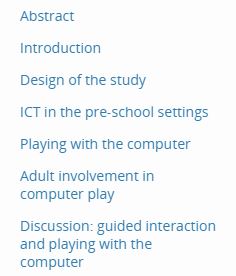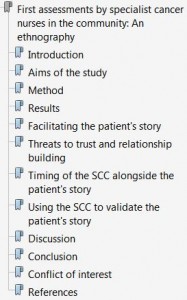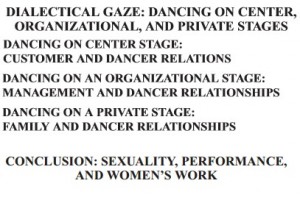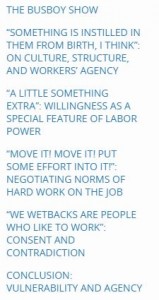 Research reports finish by telling the reader how the new knowledge contributes to what we already know. How is the field different given your results? What new understandings have emerged? Are there implications for future research or applications? Because qualitative research outcomes are communicated via conceptually rich prose, readers need the conclusion to synthesize all that information into a final overarching statement.
Research reports finish by telling the reader how the new knowledge contributes to what we already know. How is the field different given your results? What new understandings have emerged? Are there implications for future research or applications? Because qualitative research outcomes are communicated via conceptually rich prose, readers need the conclusion to synthesize all that information into a final overarching statement.
Like Introductions, the ends to qualitative papers appear to fall along a continuum from classic science prose to more narrative ethnography. When a writer situates the research on the science-y end, the final section is usually a Discussion, and may be followed by a Conclusion, both signaled by their respective functional subheadings. When the work is more purely ethnographic, the ending may be labeled a Conclusion, but just as often, is a topical subheading that hints at the final synthesis. However, to some extent, the configuration of subheadings depends on journals, too, so research that is clearly ethnographic in nature may still use the functional headings because that is what a journal requires.
 |
 |
 |
 |
While some variations exists, most qualitative reports follow a 3-part organization for the end of the paper (see below). Where both a Discussion and Conclusion are used, the Conclusion is a short (usually, a single paragraph) which summarizes the major points of the Discussion and finishes with #3 below, a final message for the future.
- Opening paragraph synthesizing the big ideas of each thematic section
- about 1 sentence per theme
- Discussion of how findings relate to the field, especially theoretically speaking
- Corroborate
- Clarify
- Conflict
- Final message for the Future
Opening Paragraphs
Each paragraph below is the first paragraph in the final section of the paper. All of these employ functional headings announcing the reader has reached the end of the paper. While not mandatory in qualitative research reports, functional headings are a courtesy to the reader. The first sentences below summarize the major finding of the study overall, as though the writer is directly answering the question the research question. The remainder of the paragraph elaborates on that global statement.
Example || Children, Play and Computers in Preschool Education
Our observations suggested that computer play does not always act as a support for learning. We found examples of software that informed children that their answer was incorrect without explaining why and other games that gave the correct response after repeated incorrect answers but did nothing to draw a child’s attention to why this was the correct response. This is unlikely to support learning and falls short of the facilitation provided by an adult who can identify the source of the error, the tentative nature of newly acquired concepts, and the benefits of directing a child to more concrete or active forms of learning. These observations point to the need not only for a more developed pedagogy for the use of computers in the playroom but also for practitioners to have opportunities to become more familiar with the software available and to be encouraged to be more critical about whether or not the learning model inherent in software matches their own models of learning and the needs of the children for whom they are responsible.
Example || First assessments by specialist cancer nurses in the community: An ethnography
The specialist nurses are ambivalent about using the SCC. They have concerns about using a tool that reduces the assessment to phenomena that are entirely measurable that could hinder the expression of human caring values and their quest for the patient’s story. While such reductionism was neither observed nor referred to during the study participants did experience tension between building the relationship on the first visit and using the SCC. In particular the SCC was thought by some to jar with the need to build trust and rapport. All the specialist nurses were careful about the timing of using the SCC and it was always used after hearing the patient’s story. Only on one occasion when the nurse had difficulty in getting the patient to tell her story was the SCC used early on in the assessment and this proved successful in cueing the patient to talk about her concerns.
Example || The Dialectical Gaze: Exploring the Subject-Object Tension in the Performances of Women who Strip
Separating the center, organizational, and private stages is an effective analytical tool to understand the different stages on which strippers must perform. As has been shown, there are clearly defined and conflicting requirements for what constitutes a “proper” performance of self for the various viewing audiences. The dancers negotiate the constraints of the “proper” performance with their own creative actions. They do this through discursive tactics that range from nonverbal displays (holding hands and laughing, while moving the customer’s hands away from their bodies), strategic secrets (counterfeiting an intimate relationship with the customer and/or the manager to control the relationship), and dark secrets (lying to family and friends about their occupations).
Example || Willing to Work: Agency and Vulnerability in an Undocumented Immigrant Network
In the introduction to this article, I posed a question: Why would presumably permanent members of the low-wage labor force put so much effort into being hard workers? Part of the answer is related to political processes that create and maintain conditions of vulnerability vis-à-vis the capitalist state (De Genova 2005; Portes and Walton 1981; Sassen 1988). In the United States, a combination of border militarization and anti-immigrant policies has not reduced the flow of labor migration but, rather, has “illegalized” it, legitimizing exploitation of immigrant workers by making access to political, economic, and social resources a right of citizenship (De Genova 2005; Massey et al. 2002; Ngai 2005). National boundaries and immigration policies produce, reinforce, and reify the distinctions among “citizen,”“legal immigrant,” and “illegal alien” (Heyman 2001; Ngai 2005; Sassen 1988). Selective enforcement of the border and the globalization of all aspects of production except for labor renders persistent labor migration all but certain (Massey et al. 2002; Portes and Walton 1981). Thus, immigration policies do not stop labor migration; rather, they generate inequality among the labor force by assigning illegal status to a segment of the working class (Heyman 2001; Lipsiz 2005; Sassen-Koob 1981).
Discussion Paragraphs
Following the opening paragraph, writers appeal to the published literature to situate the lessons from their study within the field. As with the thematic subsections, the strategy here is to craft an evidence-based dialogue identifying relationships between the major conclusions of the study and other work in the field. Doing so makes the contribution of the study clear.
Example || Children, Play and Computers in Preschool Education
Although a relationship between play and learning is well established, this relationship is under-theorised with respect to uses of computers. Wood and Bennett (1997) state that “if play provides valuable contexts for learning, it must also provide valuable opportunities for teaching” but we did not find evidence of this. Sutton-Smith (1979) points to two main ways of conceptualising play. The primary paradigm describes play as leading to cognitive and creative benefits and the secondary paradigm sees play as a form of human communication and a reflection of the enculturative processes of society. Practitioners tended to see play with computers as functioning in the secondary paradigm, particularly in terms of preparing children for the information society, but they were less able to articulate the value of play with computers in terms of cognitive development.
Analysis: blue is topic sentence identifying discussion point (one point per paragraph) — orange are discussions — bolded orange are relational statements (conflict and clarifying)
Example || First assessments by specialist cancer nurses in the community: An ethnography
The specialist nurse participants all referred to the benefits of the SCC as a prompt or ‘aide memoire’ to enquire about the psychosocial impact of cancer, and this benefit was observed as facilitating the patients to report these issues. The specialist nurses acknowledged that the SCC could fulfil this function and literature suggests patients are keen that health care professionals enquire about psycho-social issues in their lives (Cull et al., 1995; Irving, 2004; Whelan et al., 1997; Hill et al., 2003). Patients vary greatly in their ability to voice their concerns therefore it is believed that communication will be enhanced by a comprehensive and holistic enquiry into patients needs (Crooks et al., 2004). Slater and Freeman (2004) demonstrated how patients were relieved to record their psychological distress, especially if it were a sensitive concern i.e. with their family member. The action of writing their psychological concerns down was described as ‘comforting’.
Analysis: blue is topic sentence identifying discussion point. Orange is discussion — bolded orange shows this is corroborating.
Stylistics Note: Both of the above examples begin discussion-based paragraphs with classic topic sentences. As it turns out, missing topic sentences is one of the biggest complaints faculty have about student writing (unpublished research). Readers work hard to understand complex ideas; using topic sentences orients the reader to where they are in intellectual space. Just as importantly, topic sentences orient the writer! Having that key idea clearly stated in the paragraph makes it much easier not to wander off into tangential territory.
Final Paragraphs
Qualitative research ends in one of two ways, varying with the writer’s place on the classic science versus narrative continuum. Where the writer sees the work as participating in classic science prose, then the final paragraph will include both the overall message of the study as well as suggestions for future research and/or application (though they tend to be brief). Where the writer is on the narrative, ethnographic end, the final paragraph leaves the reader with final “big ideas” to consider.
Example || First assessments by specialist cancer nurses in the community: An ethnography
Conclusion
The findings of this study indicate the complex nature of the assessment phenomenon. The over-arching aims of the specialist nurses during the first assessment were to build relationships and rapport with their patients. They preferred to use the patients’ narrative as a means to develop this connection and carry out a holistic assessment. This study gives insight into the potential conflict of purpose for these specialist nurses as they undertake a first assessment and offers guidance on implementing assessment tools such as the SCC in the future. The potential for open and honest regard for the patient as an individual appears to be possible by using the SCC in a timely way and within the relationship and trust building process. While the use of the SCC will not replace intuitive and specialist skills it has the potential to help patients and professionals identify individual needs and quite possibly enhance the therapeutic relationship.
Analysis: The sentences in orange declare the major, overall messages of the study. The bolded orange words/phrases point to the content in the following sentences. In the first case, the sentence in teal synthesizes the major research findings indicated by the study, as indicated by the bolded phrase “complex nature of the assessment phenomenon”. The purple sentences are suggestions for how the a validated assessment tool can be used to by specialist nurses to increase quality of care, as suggested by the bolded orange phrase “offers guidance…”.
Example || Willing to Work: Agency and Vulnerability in an Undocumented Immigrant Network
Undocumented workers are neither mere victims or criminals, nor inherently hard workers or liberated actors free from the constraints of nation-state boundaries or hegemonies. They are complicated people who actively and creatively engage in workaday struggles to make their lives better. As they contend with racial, legal, and class constraints, they cultivate financial and emotional well-being by developing social identities as hard workers who are worthy of dignity and respect. By establishing reputations as good workers, they maintain markets for their labor and sequester job opportunities for themselves and members of their social networks. Moreover, they cultivate an identity that is consistent with their values and resistant to the stigma associated with illegal immigration.
Analysis: The orange sentences capture the big message of the study overall, with the bolded sentence being the key idea. [link to tara gray] The teal sentences each communicate a particular conclusion the writer wants the reader to leave with.